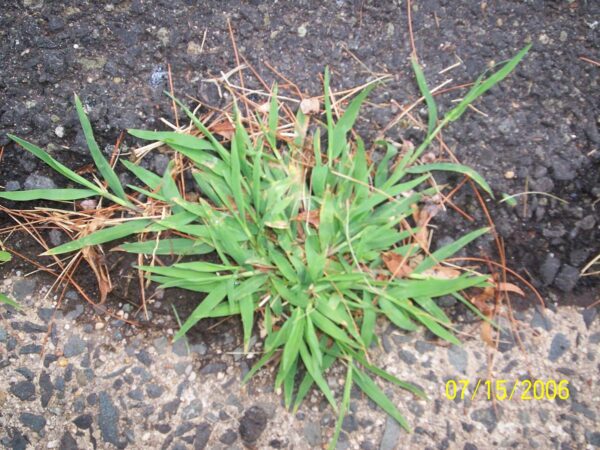How To Prevent Crabgrass Naturally
A wet spring like we’ve had this year combined with a dry summer is the perfect recipe for a crabgrass invasion. Even if you used a pre-emergent to prevent crabgrass, any conditions that increase soil compaction makes it difficult for grass to thrive, while unfortunately creating a perfect environment for weeds like crabgrass.
What is crabgrass?
Crabgrass is one of the most commonly misidentified lawn weeds. Lawn novices tend to call any thick-bladed grass that is standing out in their otherwise fine-bladed lawn crabgrass. But sometimes the thicker bladed grass is just another grass variety that was planted on a neighbor’s lawn or in the park around the corner. In the photo below we have a clump of tall fescue, one of the grass types most commonly mistaken for crabgrass.

Because it is thick bladed and much more heat and drought tolerant, it sticks out like a sore thumb in midsummer when other fine-bladed grasses might not be looking so healthy.
Here is what true crabgrass actually looks like.

As you can see, it is not growing upright like most lawn grasses. It grows in a more prostrate fashion, close to the ground. The stems extend out like legs of a crab. It also a lighter color (typically blue-green or yellow-green) than more desirable lawn grasses.
How does crabgrass end up in my lawn?
Crabgrass sprouts annually from seeds dropped the previous summer/fall. The seeds germinate when the soil has warmed up well – typically mid to late spring through early summer. The soil temperature needs to get to 55-60 degrees and stay there for about a week before crabgrass will sprout. In warmer climates it can sprout as early as February.
The crabgrass weakens the turf around it through root toxins, creating an unsightly circular patch on your lawn. It then produces numerous seeds and proceeds to drop them in the summer or early fall.
Crabgrass, which is an annual (grows for just one season) dies off soon after it has dropped its seeds, or as soon as it is hit by a frost (whichever comes first). It shrivels up and pretty much disappears by the end of winter. You will not see any crabgrass on the lawn in early spring if the lawn was hit by frost. (If you do see a clump of thick bladed grass in early spring, it is not crabgrass.)
How To Prevent Crabgrass Naturally
In our 40+ years of lawn care experience, we have seen numerous instances where crabgrass infestation stops at the property line of neighboring yards. We’ve also seen plenty of instances where lawns have been treated with chemical crabgrass preventer (pre-emergent) and crabgrass still sprouts, due to poor lawn or soil care.
Below are some things you can do to prevent crabgrass naturally.
Mow high. It might seem simple, but crabgrass likes warm soil and sunlight. It doesn’t grow in shady areas. Thick, taller lawns keep the soil cooler and prevent sunlight from reaching the soil. When you mow the lawn too short you allow the sun to reach the soil and warm it up faster than it should. You also weaken the lawn with short mowing, making it easier for crabgrass (and other weeds) to take over.
Avoid scalping the edges of the lawn along walks and driveways or beds. (Check out our blog series on mowing to learn how to mow like a pro.) Not only do people scalp lawns by incorrect mowing, but they also scalp the edges with weed wackers. Doing this is a sure way to promote crabgrass. It shortens and weakens the grass blades and causes the soil to bake and harden.
Water ahead of crabgrass season. If your lawn has plenty of moisture and is actively growing, it will be difficult for crabgrass to establish. Unfortunately, the typical homeowner won’t water the lawn until it absolutely needs it, which is often late spring or early summer, about the same time crabgrass is ready to sprout. If the lawn is dried out, the blades of desirable grass types are thinner and may even be going into a dormant state. It is not going to compete or crowd out crabgrass very well in this state.
The typical homeowner eventually sees that the lawn is really dry and gives it a good soaking. But the grass will take a few days or more (some grasses will take weeks) to recuperate and begin growing again. In the meantime, the crabgrass seeds in the ground soak up the water and sprout before the grass has had time to thicken up.
Seed early and late. A thick lawn keeps out crabgrass and other weeds. Thin or bare areas invite crabgrass in. Some grasses spread rapidly through above or below-ground runners and fill in bare spots. Other types won’t spread much and simply need more plants/seeds to get the lawn thicker. In the spring you can get your grass seed growing at least a few weeks before the soil is warm enough for crabgrass to sprout (seeding in the spring will not work if you have also put down a pre-emergent though, so time these things carefully). In the fall, after the crabgrass dies, there is usually plenty of time to seed all the thin areas of the lawn.
How to Improve Your Soil to Prevent Crabgrass
Liquid Aeration. Crabgrass loves compacted soil and clay. It also tolerates salt and other toxins your lawn does not, and thrives in very dry as well as over-wet soil. Organic fertilizers, compost, and other amendments can improve your soil structure, leading to better aeration, less clay, better drainage, and better moisture retention. By treating you yard heavily with Aerify PLUS, you will detoxify, aerate, relieve soil compaction, and make crabgrass less likely to sprout.
Lime if needed. By improving your pH you will help get more nutrients to the grass, along with the calcium that lime contains. More nutrients equals a healthier, more aggressive lawn. You can use pelletized garden lime if you have some already, or try our easy-to-apply Liquid Lime Concentrate.
Water before things look dire. As mentioned above, by the time you notice your lawn is struggling, it’s nearly too late. A lawn that looks dry, yellow, or dormant will take weeks to respond to a good watering. Also, make sure you water areas that tend to bake like by the the curb, or wherever your lawn dries out fast. In dry areas the desirable grass will weaken and thin out, making it easier for crabgrass to fill in.
Fertilize more heavily after the initial spring flush. As we said earlier, a thick lawn keeps out crabgrass. Good fertilizing will thicken the grass, making it harder for crabgrass to sprout. Most northern lawns grow vigorously once the soil warms up but will begin to slow down as late spring/summer approaches, the same time crabgrass begins to sprout. So the key time to make sure fertilizer is available, when it comes to preventing crabgrass, is after the initial spring flush of growth is over. You want to keep the grass growing aggressively before and during the time that crabgrass is trying to sprout. If you are using fast acting liquid fertilizer like our Bio-Enhanced 16-4-8, make sure to apply at this time.
If you are using a slow release organic or natural lawn fertilizer, you can fertilize heavily in the spring and it can have a profound affect on crabgrass prevention. It will keep the lawn thick and green and spreading for a few months. For crabgrass prevention purposes we suggest applying whatever formulation you use in a way that ends up with up to 2 lbs of nitrogen per 1000 sf by mid-spring. This can be split into an early and mid-spring application, or just one very heavy early spring fertilizing. If it is a slow-release organic fertilizer, it will not burn.
Corn Gluten Meal to prevent crabgrass. This is a popular non-toxic, natural fertilizer that also has substances in it that are purported to inhibit crabgrass and other weed seed germination. We have had fair to decent results using it, though we are not sure how much those results are due to the weed inhibitor and how much are due to the heavy fertilizing it gives in one shot. The product is only effective when you apply at least 20 lbs per 1000 sf before weeds and crabgrass have a chance to sprout, which equates to approximately the same 2 lbs. of nitrogen that we mentioned above.
What do I do if I have crabgrass right now?
As always, make sure your soil is healthy before you do anything else. Unfortunately, once the crabgrass has spouted, any fertilizer is going to help the crabgrass grow, too, but there are a few things you can do to get rid of it.
Remove by hand. Luckily, crabgrass tends to have shallow roots that cluster at the center. This makes it pretty easy to remove clumps of crab grass by hand, with a trowel, or with a weed pulling tool like this one.
Spray with a homemade weed killer. The only sure non-toxic weed killers are the sprays you can make at home with salt, vinegar, water, and dishsoap. Many store-bought “natural” weed killers have been proven to contain toxic chemicals like glyphosate (Roundup) that do not break down and eventually end up in our food and water supply. Check out our series on D.I.Y. weed killers for a few recipes our customers swear by.
The truth is, if you want a crabgrass-free lawn, you need to get aggressive. But with a little effort this year, you can make it much easier to prevent crabgrass next summer without any chemical pre-emergents, saving both your lawn and the environment! Over time, as your soil improves and your lawn thickens up, crabgrass won’t have a leg to stand on.
As always, if you have any questions please don’t hesitate to contact us!
This post contains affiliate links.


